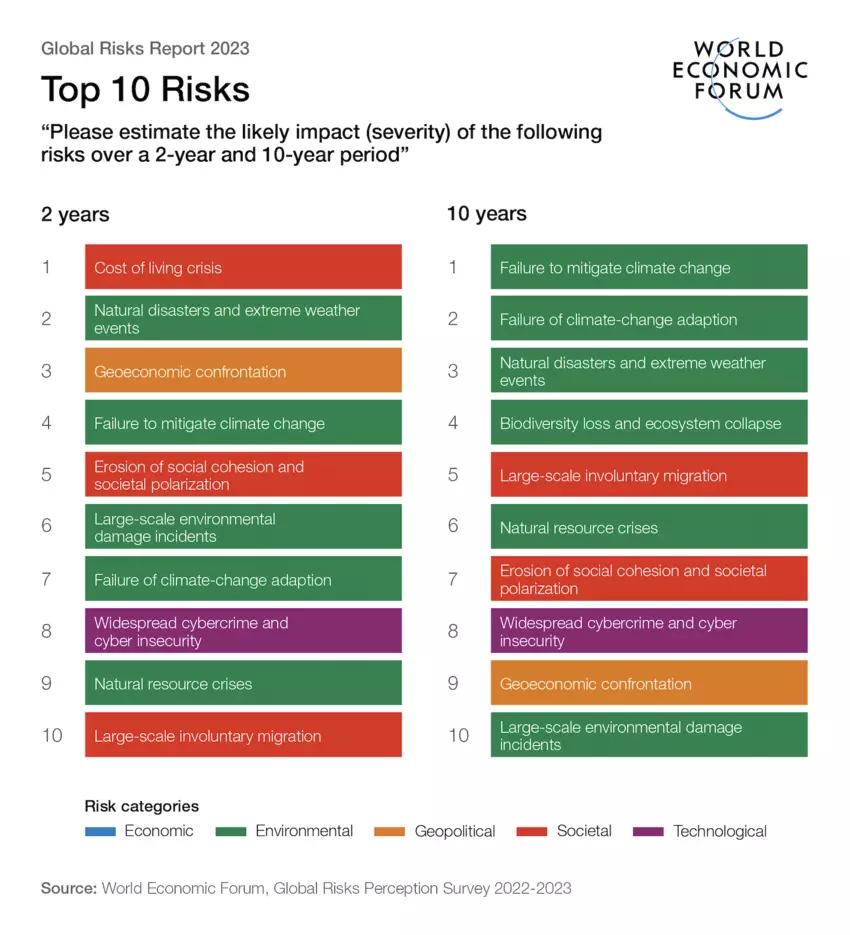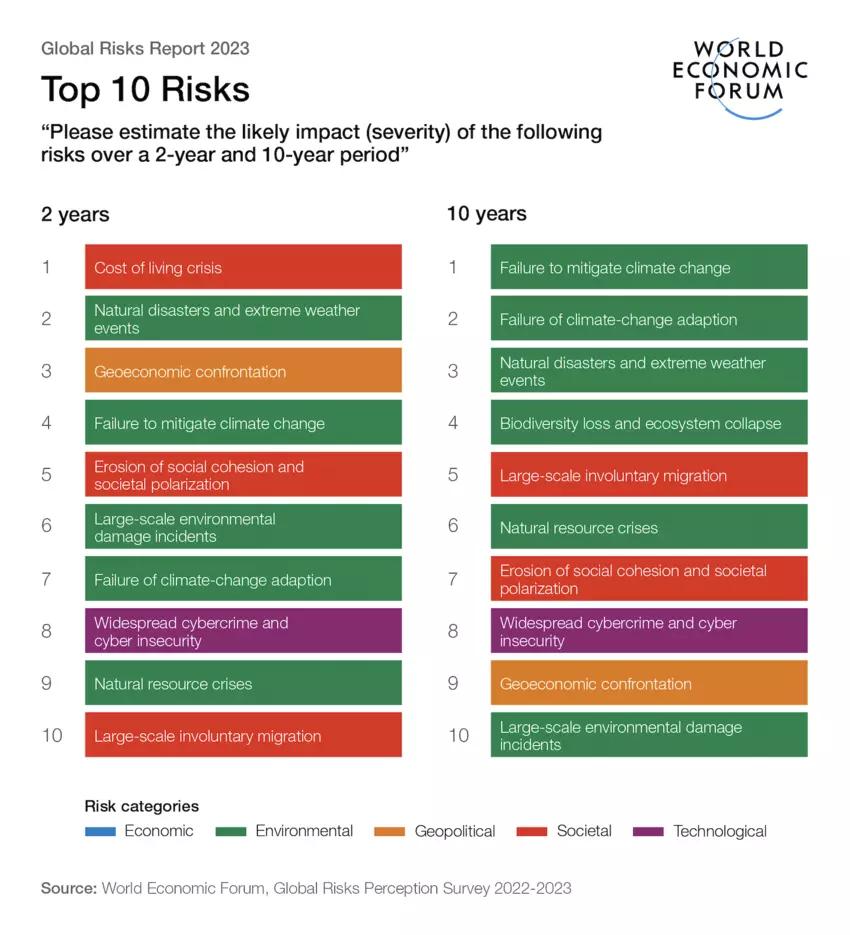Climate Change: Deep Impacts and Devastaters in the Current Society
The current climate crisis is increasingly vehement as the profound and devastating consequences that climate change can have for all aspects of our daily life emerge. The eco-systemic resources (benefits humanity obtains from nature for the satisfaction of its needs) are the basis of the economic, cultural and social system in which we develop; and its decrease or disappearance, they constitute situations of extreme vulnerability to the humanities. This phenomenon changes climate variables, ecosystems and people's lives. The environmental, economic and social impacts of climate change vary according to the territories and social structures of the different countries and cities of the world.It is a complex problem and cannot yet be seen the totality and intensity of its impacts. According to World Economic Global Risks Report (2023) Forum, the most critical global risks in the medium term correspond to issues directly related to the climate crisis. https://www. weforum.org/reports/global-risks-report-2023/digestEnvironmental impact of climate change
https://www. weforum.org/reports/global-risks-report-2023/digestEnvironmental impact of climate change- Increased temperature: The increase in global average temperature is not uniform and linear. The UN and the Red Cross warned that entire regions will become uninhabitable in the coming decades because of the heat waves, which will be increasingly frequent and intense. This intensifies desertification processes.
- Desertification: Climate changes aggravate, spread and accelerate the desertification process that is now considered one of the main environmental problems of the planet. The concept does not refer to the physical expansion of existing deserts, but to the processes that threaten to transform into deserts some ecosystems that are currently not. Today, two-thirds of the Earth are immersed in a desertification process, and by 2050, 1.5 million km2 of agricultural land will be lost which are essential to maintain biodiversity, ecosetemic services and feed the population.
- Forest fires: With an upward global average temperature, it generates a favorable environment for natural fires. Forest fires are increasingly frequent, expansive and severe. In each fire are released tons of carbon in the atmosphere, further aggravating the greenhouse effect. Forest fires are one of the biggest causes of habitat loss and biodiversity. To this, it is necessary to add that often forest fires are caused by causes imputable to human activity (accidental or intentional). Some authors speak of forest superincendia (by violence, speed and extension) which are increasingly difficult to contain and accelerate global warming.
- Change in precipitation and water cycle: Global warming favors evaporation of water masses as rivers and oceans, increasing the amount of water vapor contained in the atmosphere. Larger steam volumes intensify torrential precipitation. At the global level, there is a higher frequency and intensity of intense precipitation and its associated adverse effects, such as destructive winds and floods.
- Ice mass melting (glaciares, Arctic, Antarctic, permafrost): Arctic is a clear example of how rising temperature is not a uniform process. The north and south poles and glaciers are cooling focuses. Not only do they contribute to lowering the temperature, but the whiteness of its surface reflects and returns to the atmosphere a large amount of solar radiation. Currently, ice layers disappear, which causes the opening of dark surfaces of water and soil that begin to retain radiation, accelerating the increase in water temperature and atmosphere. In the Arctic, the temperature rises two or three times faster than the global average. The melting of the permafrost produces the release of methane contained in the ice, which has a much greater heating potential for other greenhouse gases.
- Ocean acidification: The increase of carbon dioxide in the atmosphere changes the ph of the oceans. Seas absorb more than 25% of global carbon dioxide emissions. When contacting water, carbon dioxide forms a compound called carbonic acid, which contributes to the acidification of the sea. Acid environments have different impacts on marine biodiversity. It mainly affects coral, algae and plancton which are fundamental to maintain biological processes and are the basis of marine trophic chains.
- Extreme weather events: The heat of the ocean, the humidity of the air and the wind are some of the variables that considerably influence the formation of hurricanes and storms. Hurricanes are complex, but one of the main factors determining their strength is the surface temperature of the ocean: the hottest water provides greater energy that fuels the storms. Extended heating of the ocean surface and increased atmospheric humidity favors the formation of the orphan storms and the most powerful dota.
- Disappearance of biodiversity: Climate change has several negative impacts on planetary biodiversity and ecosystems. Variations in temperature and seasonal changes flowering times and plant growth, as well as migration or species reproduction. The transformations in ecosystems cause expansion or contraction of the geographical areas of species and affect their interactions. The loss of habitats reduces populations, to such a point that some experts say that we are witnessing the sixth massive extinction of species, with special involvement to vertebrates. The disappearance of a large number of species of plants and animals will alter the biological functions of ecosystems, which will cause a stroke and alteration of the biological balance of the whole system.
- Demographic impacts: The occurrence of extreme meteorological phenomena such as floods, droughts, desertification, temporary and hurricanes and difficulties to access food and drinking water will generate the need for displacement of a large number of people, who will have to leave their homes and find new spaces where to inhabit and develop. These people who will be forced to move are informal as climate refugees. It is estimated that by 2050, between 25 million and billion people move directly to climate change. This migratory volume represents the largest and deepest humanitarian crisis in history.
- Increased poverty: As mentioned earlier, climate change puts pressure on current social structures and emphasizes existing inequalities. Environmental degradation and the decrease in the production of low food in crop, drought and flood yields, food prices are expected to rise, which makes it difficult to access adequate nutrition and food for many more people than those currently suffering. In addition, it will deepen the shortage of food for the most vulnerable populations, aggravating the problem of poverty worldwide.
- Food: Global warming seriously affects agriculture and water resources, affecting food production. This has direct consequences on the cycles of species and soils. Food producers should adapt to droughts, high temperatures and colds. This will affect agriculture in different ways across the planet and will have direct consequences on the food security of people (understood as access and nutritional quality of food). The inability to predict seasonal weather conditions decreases crop yield and thus the availability of food. In addition, temperature variations, rainfall and seasons promote the emergence and propagation of non-usual herbs and pests and require the transformation of the crop zones. Every time the plant species develop in certain soils and under certain conditions, they may become unfit for traditional crops that are the basis for the feeding of local populations. In relation to livestock production, one can see affected by the decrease in the availability of space, food and water for cattle.
- Water: Climate change will lead to a change in water resources, which will lead to prolonged dry periods that hinder access to drinking water and sanitation. The increase in global temperature produces water shortages. This has direct and serious impacts on people's lives on food security, health and economic activities. It not only increases water stress of the populations, but also puts at stake the quality of the water available. A lower availability of the resource increases pressure by access to drinking water sources. This effect will be more serious for areas that already encounter difficulties in accessing water. A higher evaporation rate as a consequence of higher temperatures will feed the extreme meteorological phenomena.
- Health: Temperature changes with their consequent changes in precipitation regimes and ecosystems can convert the temperate zones into territories conducive to the spread of diseases. It may favor the appearance of malaria, cholera, dengue and other diseases caused by vectors that find areas conducive to its spread. Many of these diseases are considered forgotten or nonexistent in cold and/or developed climate countries. However, this reality could change with the rise of the global average temperature. It is essential to mention the risks of the appearance of zoonosis diseases that are transmitted by animal species to the human being: The monkey's smallpox, covid-19, HIV-AIDS, the Western Nile virus, Ebola and MERS are diseases of zoonoses. With the progressive disappearance of natural habitats on animals in inhabited areas, more frequent and narrow interactions can result in the emergence of new diseases for the human species. On the other hand, heat causes cardiovascular diseases to increase and many more respiratory problems such as allergies or asthma appear. Finally, with higher levels of waste and industrial activity concentrated in centers of higher population density, the health problems derived directly from contamination caused by human activity increased.
- Insular Poblations: Insular populations are very vulnerable to the impacts of climate change, not only by rising at sea level that can submerge them completely or partially under water, but may also cause difficulties in the lack of access to drinking water (by corruption of reserves and salting of soil) and food, can severely affect local infrastructure and the disappearance of resources on which they base their economy (such as corals and marine biodiversity). In addition, the increased frequency of extreme meteorological phenomena puts them in a situation of greater risk and greater probability of forced migration due to climate change. According to the different projections and scenarios of rising sea level, some island states could completely disappear from the map. This, in addition to the problem of climate refugees, illustrates that climate change has the potential to change the demographic distribution of the planetary population, which will have a special impact on the pressures for access to natural resources.
- Social trends, geopolitics and armed conflicts: The increased need for access to natural resources could increase political tension between different social actors. In high-voltage contexts, conflicts arise that can derive and scale in situations of progressive violence, until they reach armed conflicts. UN studies show that most of the international armed conflicts of the last century were motivated by access to certain natural resources. Given the proliferation of nuclear weapons and weapons of mass destruction, a scenario of widespread social and political tension could have catastrophic consequences for humanity.
- Genre: We have previously mentioned that climate change expands and aggravates existing inequalities, and have a greater negative impact on the most vulnerable populations. In different places on the planet, women have less access to natural and economic resources and are therefore more vulnerable to the consequences of climate change. In addition, social tensions show rises in levels of violence for women.




Comments